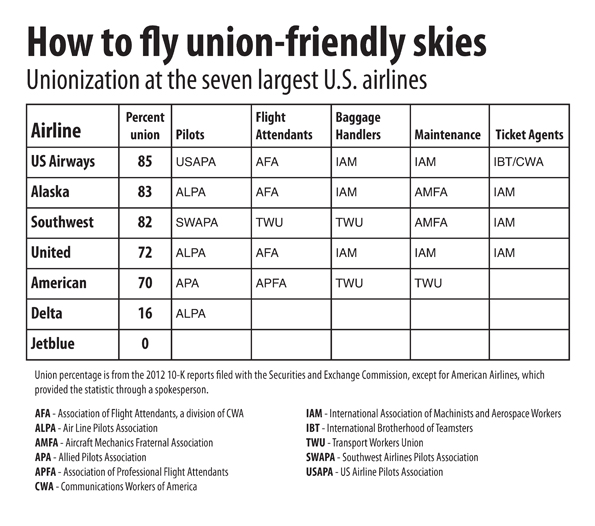From NW Labor Press:
Fly the union-friendly skies, if you can find them
Do you fly airlines where the workers have union representation, or airlines that have kept unions out? To help you know which is which, the Northwest Labor Press consulted company annual reports and data from the DOT’s Bureau of Transportation Statistics, and contacted airline unions. The findings: U.S. airlines range from 85 percent unionized US Airways to totally nonunion JetBlue.
It’s been a wild ride for airline industry workers since the Airline Deregulation Act of 1978. Passed over the objection of airline unions, that legislation got rid of fare and route regulation, and began an era of fierce competition, with wave upon wave of mergers and bankruptcies, a gradual disappearance of passenger perks, and continual pressure on workers. In the decades since it passed, PanAm, Republic, and Northwest were absorbed by Delta; Continental by United; TWA by American; and America West merged into US Airways. Today, those four surviving “legacy” companies, plus Southwest, JetBlue, and Alaska control over 80 percent of the U.S. market.
Every one of the legacy carriers — airlines that existed before deregulation — has filed for bankruptcy at one point since then, and some more than once. And when they do, management uses bankruptcy law as a bludgeon to modify union contracts.
Here are some employee relations highlights from the Top 7 airlines, starting with the largest:
Southwest, headquartered in Dallas, became the biggest U.S. airline by “revenue passenger miles,” after acquiring AirTran in 2011. It also has the best relationship with its unions, and the highest customer satisfaction ratings.
Delta, headquartered in Atlanta, has fought employee efforts to unionize for decades. When it absorbed heavily-unionized Northwest Airlines in 2010, those 17,000 workers lost their unions. And Delta is having a big impact on conditions at other companies: More than other airlines, Delta relies on regional airlines as subcontractors on smaller flights to smaller cities, and it has used its market clout to drive down costs and wages, in the same way that WalMart does with its suppliers.
United Airlines, headquartered in Chicago, was in bankruptcy from 2002 to 2005, during which it negotiated concessions from its unions. It’s a major outsourcer, too, both of maintenance work, and of routes: Many flights sold by United are operated by subcontractors. This year United completed a merger with Continental.
American Airlines, headquartered in Ft. Worth, is the airline villain of the moment. On Oct. 3, it lost a year-long court battle to prevent 10,000 ticket agents from unionizing with Communications Workers of America. CWA supporters have begun fliering at airports to alert customers about rampant outsourcing. American filed for bankruptcy last November despite billions in cash reserves, and its plans in bankruptcy are to cut 13,000 employees, outsource maintenance, terminate all of its pension plans, and end retiree medical coverage. This is after American’s unions agreed to major concessions in 2003 to keep the company out of bankruptcy. This time around, the unions have said no, but American is asking a judge to order contract changes. Pilots are fighting back with record numbers of sick-ins and “working to rule” — instead of helping the airline limp along, they’re writing up every equipment failure. American has been in discussions about a merger with US Airways.
US Airways, headquartered in Tempe, Arizona, just swallowed America West, and now is making a bid to take over much-larger American Airlines. Its flight attendants rejected a tentative agreement and were scheduled to hold a strike authorization vote Oct. 31 (after this issue went to press.)
JetBlue, a low-cost carrier headquartered in New York City, is all non-union and determined to stay that way, defying an active campaign by Transport Workers Union to unionize flight attendants. JetBlue enters into five-year “agreements” with individual employees, in which it unilaterally commits to “just cause” discipline and protection against layoffs.
Alaska Airlines, headquartered in Seattle, began as a regional carrier in the Pacific Northwest. Now it’s the seventh largest airline nationally. It has relatively good relations with its unions, though new hires no longer get to enroll in the company’s defined-benefit pension plan.
ANd read more at the original site, for whether the plane manufacturers are union.


















